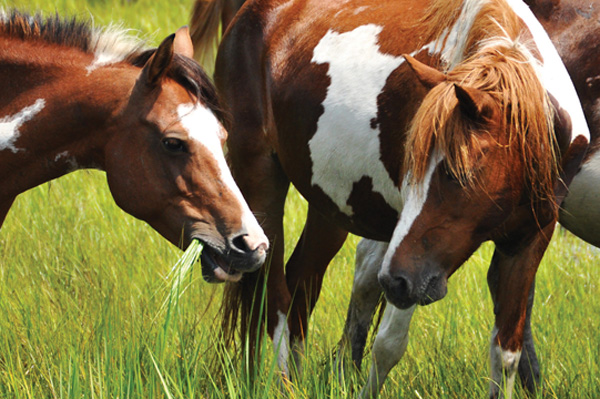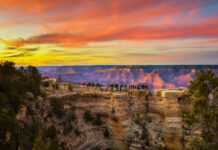Some people hear “Chincoteague” and immediately think of a certain beloved pinto named Misty, made famous by writer Marguerite Henry in 1947. But to other, less horse-oriented people, Chincoteague is known as a birder’s paradise, and still others treasure it as a wildlife refuge. It can be a sanctuary for humans, too, especially those in need of low-key downtime that isn’t too hard on the wallet.
Off the coast of Virginia and a three- hour drive from Baltimore or Washington, the island is just far enough away to have mostly slid under the radar of developers. There are a few oversized hotels and tourist shops, but by and large it feels like the hermit of beach towns—remote, shy and a bit rough around the edges.
Summers in Chincoteague are hot, and in July, when the pony roundup happens, “sweltering” is apt. But my sweetie and I decamped to Chincoteague for a weekend in April, when the weather ranged from raw and windy to sunny and crisp. With scarves and hats, we were able to enjoy springtime in nature, with a bonus of off-season hotel prices.
Our first morning, after sticky buns at Sugarbakers, we decided to make an informal visit to an aquaculture operation. The island has a long history with the fishing industry, and its “Chincoteague salt oysters” have earned a reputation for their briny flavor. (Connoisseurs credit the Atlantic Ocean for giving them their sweet, salty taste.)
We drove to Tom’s Cove Aquafarms, parked and checked out the oysters in nets near the surface of the water, which keeps them free of silt, and the clams raised nearby. We were the only people at the farm aside from one of its employees, who explained how they spawn the shellfish and what they feed them. (“Mostly phytoplankton,” he said.)
Our next stop was the Assateague Lighthouse, a popular site for tourists. The active lighthouse, banded in red and white, overlooks the refuge. Admission is free, although donations are gladly accepted, and a ranger regulates the number of people allowed in to climb to the top. The stairs are narrow and steep and the circular climb was a bit dizzying, but everyone was cheerful. From the keeper’s quarters at the top, where the keeper huddled with a cup of coffee, we were able to step outside for a 360-degree view of the refuge—by far the most windblown moment of the weekend.
The Chincoteague National Wildlife Refuge is located on the barrier island of Assateague, Chincoteague’s feral sister and only a short drive through town. The day pass, issued by the U.S. Fish and Wildlife Service, costs a mere $8, and for that you can spend the day walking or biking alongside salt marshes, dunes and maritime forest. The refuge’s Wildlife Loop, about 3 miles, is popular, but barely populated (by humans) in April. The Wildlife Loop is home to egrets and herons, shorebirds and songbirds. Also—piping plovers, swallows, redwings, eagles and ospreys. While we saw many, many birds, we saw only a couple birders with their enormous cameras.
Let’s not forget the pintos. Feral ponies roam the refuge, coming and going as they please. (Actually, they’re not ponies; they’re small horses, stunted from generations of malnutrition—a diet of marsh plants and brush will do that.) They graze among egrets and herons, completely unconcerned. These were the most blasé horses. When we approached for photos, they could barely be bothered to look at us.
In April, that marshy territory was lovely. The most distinct sound there, for me, was the electronic-sounding chirps of the redwings. Tree swallows swooped through the wide sky, catching insects on the wing, occasionally checking into one of the many swallow houses erected in the marsh. Green herons waded silently in the marsh—until, quick as lightning, they dipped below the surface and became cold, hard killers of fish. Flocks darkened the sky, then spread apart to let in the crisp light. The air was clean and raw. The sun made the marsh plants translucent. I won’t swear to it, but I’m pretty sure we spied at least one osprey and one bald eagle.
That night after dinner we went to Steamers, which serves several beers on draft and lots and lots of bar food. It was April, so baseball season had started, and I had the distinct pleasure of drinking a whisky while watching both the Orioles and the Nationals play on side-by-side televisions. I was able to listen in while the bartender and one of her customers tried to figure out how to make a Colorado Bulldog. The customer’s phone provided the answer: It’s a White Russian plus Coca-Cola.
The next morning we had breakfast at the Chincoteague Diner and Restaurant, where my sweetie satisfied a craving for scrapple. For second-breakfast, we paid a visit to the donut truck known as the Sandy Pony. If there’s one thing you can’t miss on Chincoteague, it might be the donut truck.
We returned to the refuge and explored some of the other paths, then checked out the wooden walkway and the information center, and overheard scraps of a conversation with one of the rangers: “Well, it’s a good day, I guess. I woke up on the right side of the dirt.”
We decided to explore the Woodland Trail and the Bivalve Trail, both of them very different from the Wildlife Loop. The Woodland Trail is as the name suggests—a path through piney woods. It leads to the Bivalve Trail, which lets out onto the beach and has an altogether different feel from the wooded portion. Because of a Southern pine beetle infestation, the loblolly pines on hundreds of acres have died. What’s left is pale, bare tree trunks that stand against the sky, giving the impression of a vertical boneyard. There’s a sharp, clean beauty at that beach, and in April, the water was warm enough to wade into. I did.
WHERE TO EAT
Sandy Pony Donuts
This donut truck delivers hot, fresh, thick and cakey donuts in unusual flavors. The Porky Pony offers a combo of honey, cinnamon-sugar and bacon, and they don’t go easy on the bacon. Other donuts feature peanut butter, coconut and thin mints (not together, though that’s not a bad idea).
6758 Maddox Blvd.
Sea Star Café
This little pond-side building under some pines serves terrific sandwiches, wraps, soups, cold drinks and brownies, with plenty of vegetarian and vegan options. You can take your food to go or grab one of the picnic tables. But take heed: The lines can be super-long.
6429 Maddox Blvd.
Poseidon’s Pantry
This little shop sells things you don’t expect to find in a humble beach-town deli: specialty cured meats, perfectly brined olives, exciting flavors of dark chocolate, fancy cheeses, interesting beer … plenty for a foodie picnic basket or for stocking up on consoling delectables for the drive home.
6219 Maddox Blvd.
Sugarbakers
The coffee here is decent, but people come for the sticky buns. Cute-shop in the historic district, strolling past quaint, old houses with bun in hand.
4095 Main St.





